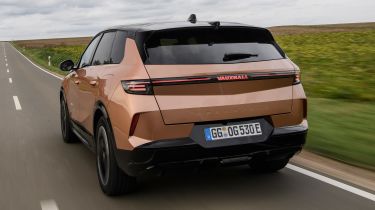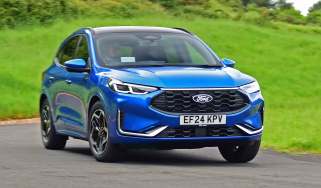Vauxhall Grandland - MPG, emissions & running costs
Whether you choose the mild-hybrid or full-electric powertrain, the Vauxhall Grandland provides impressive efficiency

| Model | MPG | CO2 | Insurance group |
| Vauxhall Grandland | 51.4mpg | 125g/km | TBC |
The Vauxhall Grandland comes with a relatively low drag coefficient of 0.28, which not only helps the all-electric model, but the economy of the mild-hybrid, too. Many of the Grandland’s MHEV rivals will fail to crack 50mpg on a combined cycle, so claimed 51.4mpg combined efficiency is impressive.
Vauxhall says that 50 per cent of urban driving can be done on electric power only, and we found that the electric motor is happy to provide a surprising amount of the Grandland’s power at low speeds, despite having only 28bhp. The motor can be used at up to 84mph, too.
CO2 emissions of 125g/km for the mild-hybrid Grandland are pretty impressive, beating rivals like the Ford Kuga Full Hybrid (132g/km), Toyota RAV4 (130g/km) and the mild-hybrid Hyundai Tucson (142g/km).
A plug-in model will join the range down the line, combining the same 1.2-litre three-cylinder engine with a larger e-motor and battery pack that should be able to drive for up to 50 miles on electric power alone. Efficiency figures have yet to be revealed for the PHEV, but expect them to be high, based on heavy utilisation of the electric-only mode.
Electric range, battery life and charge time
| Model | Battery size | Range | Insurance group |
| Vauxhall Grandland Electric | 73kWh | 325 miles | TBC |
| Vauxhall Grandland Electric Long Range | 97kWh | 435 miles | TBC |
The Grandland Electric is initially offered with a 73kWh battery with a maximum range of 325 miles. A larger battery version is coming with 97kWh capacity, and up to 435 miles. You’ll find both of these batteries in the Peugeot E-3008, with ranges of 326 miles and 422 miles respectively.
Used - available now

2020 Ford
Kuga
16,328 milesAutomaticPetrol2.5L
Cash £19,522
2025 Audi
A4 Avant
15,879 milesAutomaticPetrol2.0L
Cash £26,959
2023 Jaguar
F-Pace
38,583 milesAutomaticPetrol2.0L
Cash £31,485
2021 Audi
Q3
51,337 milesManualDiesel2.0L
Cash £17,440As part of the warranty agreement, the Grandland Electric’s battery is protected for up to eight years and 100,000 miles. Vauxhall will also guarantee the battery will hold up to 70 per cent of its charge during this period.
With 400V architecture, charging speeds for the Grandland Electric are average for the large EV segment, with the 97kWh battery coming with 160kW capability. This allows for a 10 to 80 per cent top-up in 26 minutes. The 73kWh battery model only provides 100kW charging, equating to a 10 to 80 per cent top-up of 30 minutes. An on-board 11kW charger is included, which takes four-and-a-half hours to do the same recharge.
Brake regeneration comes as standard and features three levels of recuperation. We found each level to provide a distinct difference in terms of strength, although one-pedal driving isn’t quite possible.
Tax
The Grandland Hybrid falls into the 30 per cent Benefit-in-Kind (BiK) tax band thanks to its emissions of 125g/km, while the all-electric model attracts a two per cent BiK rate. Company car buyers might be further tempted by the plug-in hybrid model due shortly, which should sit in the eight per cent bracket thanks to 50 miles of EV-only range.
All hybrid Grandlands sit under the £40,000 mark, while all pure-electric versions are above that price point. In 2025, when VED charges change for all-electric cars, Grandland Electric owners will be liable for road tax.
Insurance groups
Insurance groups for the latest Vauxhall Grandland haven’t been revealed yet.
Depreciation
The previous-generation Grandland held on to 51 per cent of its value after three years and 60,000 miles, with the plug-in hybrids faring the best. It’s too early to tell how the new model will perform, but we expect residuals to be as good, if not better, than was the case with the older car.








